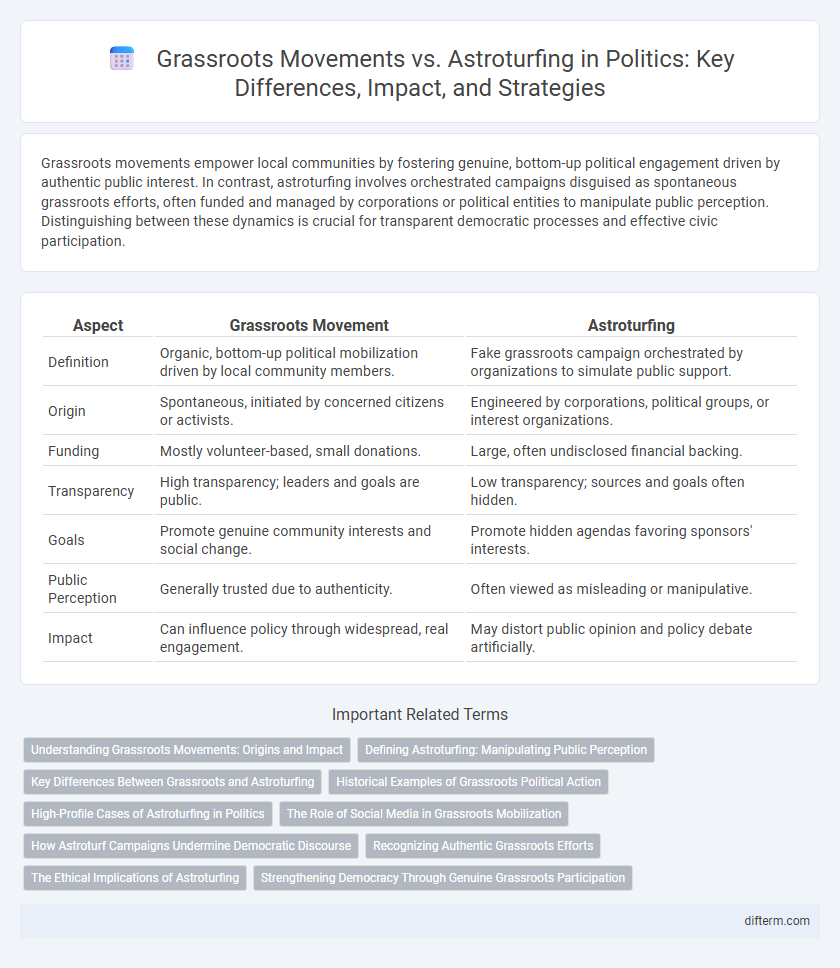Grassroots movements empower local communities by fostering genuine, bottom-up political engagement driven by authentic public interest. In contrast, astroturfing involves orchestrated campaigns disguised as spontaneous grassroots efforts, often funded and managed by corporations or political entities to manipulate public perception. Distinguishing between these dynamics is crucial for transparent democratic processes and effective civic participation.
Table of Comparison
| Aspect | Grassroots Movement | Astroturfing |
|---|---|---|
| Definition | Organic, bottom-up political mobilization driven by local community members. | Fake grassroots campaign orchestrated by organizations to simulate public support. |
| Origin | Spontaneous, initiated by concerned citizens or activists. | Engineered by corporations, political groups, or interest organizations. |
| Funding | Mostly volunteer-based, small donations. | Large, often undisclosed financial backing. |
| Transparency | High transparency; leaders and goals are public. | Low transparency; sources and goals often hidden. |
| Goals | Promote genuine community interests and social change. | Promote hidden agendas favoring sponsors' interests. |
| Public Perception | Generally trusted due to authenticity. | Often viewed as misleading or manipulative. |
| Impact | Can influence policy through widespread, real engagement. | May distort public opinion and policy debate artificially. |
Understanding Grassroots Movements: Origins and Impact
Grassroots movements originate from the collective efforts of ordinary citizens advocating for social or political change, reflecting genuine community interests and fostering democratic participation. These movements often emerge spontaneously in response to local or national issues, gaining momentum through organic support and active engagement. Understanding the authentic origins and impact of grassroots initiatives is crucial for distinguishing them from astroturfing, which involves artificially manufactured campaigns designed to simulate grassroots support.
Defining Astroturfing: Manipulating Public Perception
Astroturfing is a deceptive political strategy that fabricates the appearance of a genuine grassroots movement to manipulate public perception and influence policy decisions. Unlike authentic grassroots campaigns driven by community members, astroturfing employs paid actors, fake online profiles, and orchestrated messaging to create false consensus and manufactured support. This manipulation undermines democratic processes by distorting public opinion and eroding trust in legitimate political advocacy.
Key Differences Between Grassroots and Astroturfing
Grassroots movements emerge organically from the community with genuine support and participation, reflecting authentic public interest. Astroturfing involves orchestrated campaigns funded by organizations or interest groups to simulate grassroots support, often misleading the public and policymakers. The key difference lies in the authenticity and source of the mobilization, where grassroots is bottom-up and volunteer-driven, while astroturfing is top-down and strategically engineered.
Historical Examples of Grassroots Political Action
The Civil Rights Movement of the 1960s exemplifies effective grassroots political action, where local activists organized protests, voter registration drives, and community meetings to challenge segregation and discrimination. The 2011 Egyptian Revolution demonstrated how grassroots mobilization through social media and street protests led to the ousting of President Hosni Mubarak. These historical examples highlight the power of genuine community-driven efforts in shaping political change, contrasting sharply with astroturfing, which involves artificial, top-down campaigns designed to mimic organic public support.
High-Profile Cases of Astroturfing in Politics
High-profile cases of astroturfing in politics illustrate orchestrated campaigns masquerading as grassroots movements to manipulate public opinion and policy decisions. Notable examples include the 2009 American Medical Association's covert efforts against healthcare reform and the 2010 Citizens United case, which revealed undisclosed funding influencing elections. These incidents underscore the challenges in distinguishing authentic civic engagement from deceptive political strategies engineered by powerful interests.
The Role of Social Media in Grassroots Mobilization
Social media platforms serve as critical tools for grassroots movements by enabling widespread, organic mobilization and real-time communication among supporters, thereby fostering authentic community engagement and collective action. These platforms amplify genuine voices and facilitate decentralized organization, contrasting sharply with astroturfing campaigns that rely on artificial, orchestrated efforts to simulate grassroots support. The democratizing effect of social media enhances transparency and accountability in political activism, making it harder for astroturfing to deceive the public or mask vested interests.
How Astroturf Campaigns Undermine Democratic Discourse
Astroturf campaigns manipulate public opinion by creating the illusion of widespread grassroots support, distorting authentic political engagement and misleading voters. These orchestrated efforts erode trust in genuine grassroots movements, weakening democratic discourse and the accountability of elected officials. The prevalence of astroturfing consolidates power among special interest groups, marginalizing diverse voices essential for a healthy democracy.
Recognizing Authentic Grassroots Efforts
Authentic grassroots movements emerge spontaneously from community members driven by shared concerns, characterized by genuine local engagement and transparent organization. Indicators include decentralized leadership, organic growth, and reliance on volunteer participation rather than paid professionals. Distinguishing these efforts from astroturfing requires scrutiny of funding sources, messaging uniformity, and the presence of corporate or political interests orchestrating the campaign behind the scenes.
The Ethical Implications of Astroturfing
Astroturfing, the practice of masking sponsors to create a false impression of grassroots support, raises significant ethical concerns including deception and manipulation of public opinion. It undermines transparent democratic processes by distorting genuine political engagement and eroding trust in authentic grassroots movements. The ethical implications highlight the importance of accountability and honesty in political advocacy to preserve democratic integrity.
Strengthening Democracy Through Genuine Grassroots Participation
Genuine grassroots participation fosters authentic political engagement by empowering citizens to influence policies from the ground up, enhancing democratic accountability and transparency. Unlike astroturfing, which manufactures artificial support through hidden agendas and corporate interests, grassroots movements build trust by reflecting real community concerns and mobilizing diverse voices. Strengthening democracy depends on promoting these organic efforts to ensure policymaking remains responsive to the electorate's true needs and priorities.
grassroots movement vs astroturfing Infographic

 difterm.com
difterm.com